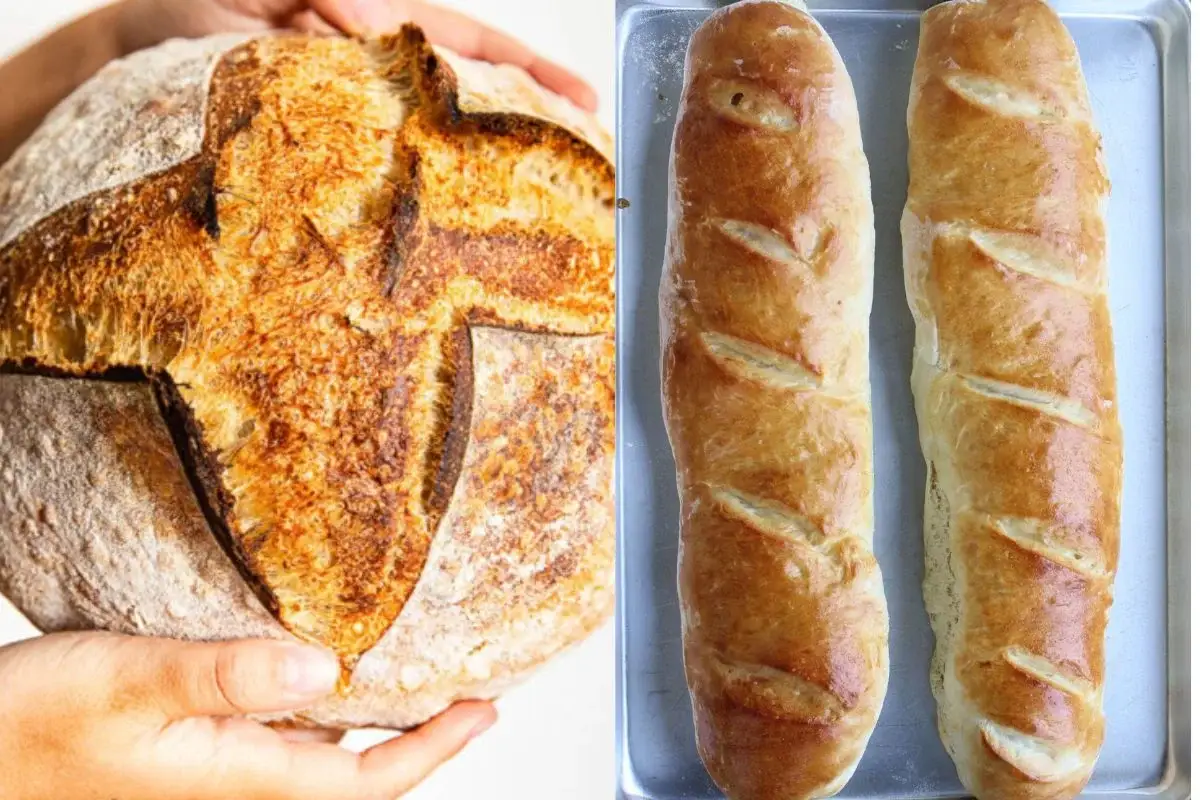
Differences in Sourdough Bread and French Bread
When it comes to bread, there are countless varieties that cater to different tastes and preferences. Sourdough bread and French bread are two popular options, each with its own distinct characteristics and flavors.
In this article, we will delve into the differences between sourdough bread and French bread, exploring their unique qualities and providing insights into what sets them apart. So, let’s embark on this culinary journey and uncover the nuances of these two beloved bread types.
Table of Contents
ToggleWhat is Sourdough Bread?
Sourdough bread is a type of bread made using natural yeast and lactic acid bacteria, which results in a characteristic tangy flavor. Unlike commercial yeast, which is used in most bread recipes, sourdough bread relies on a fermented starter that contains wild yeast and bacteria. This starter is a mixture of flour and water that undergoes a fermentation process, developing complex flavors and a unique texture.
What is French Bread?
French bread, often referred to as “baguette,” is a classic type of bread that originated in France. It is characterized by its elongated shape and crispy crust. French bread typically contains flour, water, yeast, and salt, and it is known for its light and airy texture. It is a staple in French cuisine and is enjoyed both on its own and as an accompaniment to various dishes.
The Origins of Sourdough Bread and French Bread
Sourdough bread traces its roots back to ancient times when commercial yeast was not readily available. People relied on natural fermentation to leaven their bread, leading to the creation of sourdough.
On the other hand, French bread emerged during the early 19th century when the French government established regulations for bread production, resulting in the iconic baguette we know today.
Differences in Ingredients
The ingredients used in sourdough bread and French bread differ slightly, contributing to their distinct qualities. Sourdough bread primarily requires flour, water, and a sourdough starter, which is a fermented mixture of flour and water.
French bread, on the other hand, includes flour, water, yeast, and salt. The absence of a sourdough starter in French bread affects its flavor and texture.
Fermentation Process
One of the significant differences between sourdough bread and French bread lies in their fermentation process. Sourdough bread relies on the natural fermentation of the sourdough starter, which contains wild yeast and bacteria.
This fermentation process can take several hours or even days, allowing the dough to develop complex flavors. In contrast, French bread typically undergoes a shorter fermentation period using commercial yeast, resulting in a milder taste.
Texture and Crust
The texture and crust of sourdough bread and French bread also set them apart. Sourdough bread has a chewy texture with irregular air pockets, thanks to the long fermentation process.
Its crust tends to be thick and crispy, offering a delightful crunch when bitten into. On the other hand, French bread has a lighter and airier texture, with a thin and crispy crust that crackles as you break it apart.
Flavor Profile
The flavor profile is perhaps the most distinctive aspect that separates sourdough bread and French bread. Sourdough bread boasts a complex and tangy flavor, owing to the fermentation of the sourdough starter.
The wild yeast and bacteria present in the starter contribute to its unique taste. French bread, on the other hand, has a milder and more neutral flavor, allowing it to complement a wide range of dishes.
Shelf Life
When it comes to shelf life, sourdough bread and French bread differ significantly. Sourdough bread has a longer shelf life compared to French bread. The lactic acid produced during fermentation acts as a natural preservative, slowing down the staling process.
French bread, with its minimal use of fat and lack of preservatives, tends to go stale more quickly. It is best enjoyed fresh on the day of purchase.
Nutritional Value
In terms of nutritional value, both sourdough bread and French bread offer certain benefits. Sourdough bread, thanks to the fermentation process, is easier to digest compared to other bread types.
It also has a lower glycemic index, meaning it causes a slower rise in blood sugar levels. French bread, on the other hand, is low in fat and cholesterol, making it a healthier option when consumed in moderation.
Regional Variations
While sourdough bread and French bread have their traditional forms, there are regional variations that add further diversity to these bread types.
Different countries and cultures have their take on sourdough bread and French bread, incorporating local ingredients and techniques. These variations showcase the versatility and adaptability of these breads, making them even more intriguing to explore.
Popular Uses
Sourdough bread and French bread are both incredibly versatile and can be used in various ways. Sourdough bread is often enjoyed on its own, toasted with butter, or used as a base for sandwiches and bruschetta.
Its tangy flavor adds a delightful twist to any dish. French bread, with its light and crispy texture, is perfect for making sandwiches, crostinis, and canapés. It also pairs well with cheese and charcuterie.
Baking Techniques
The baking techniques for sourdough bread and French bread differ due to their unique characteristics. Sourdough bread requires a longer fermentation process and benefits from baking in a Dutch oven or a covered cast-iron pot.
This helps create steam and retain moisture, resulting in a better rise and a crustier crust. French bread, on the other hand, is typically baked on a baking stone or a perforated baguette pan to achieve its signature shape and crust.
Health Benefits
Both sourdough bread and French bread offer certain health benefits. Sourdough bread, due to the fermentation process, contains beneficial bacteria that promote a healthy gut microbiome. It is also a good source of essential nutrients like iron and B vitamins. French bread, being low in fat and cholesterol, can be part of a balanced diet and provides energy through carbohydrates.

How to Make Sourdough Bread
If you’re interested in making sourdough bread at home, here’s a simple recipe to get you started:
Ingredients:
- 500g bread flour
- 350g water
- 100g sourdough starter
- 10g salt
- In a mixing bowl, combine the flour, water, and sourdough starter. Mix until a shaggy dough forms.
- Add the salt and continue kneading the dough until it becomes smooth and elastic.
- Cover the bowl with a damp cloth and let the dough ferment at room temperature for several hours or overnight, until it doubles in size.
- Shape the dough into a loaf and place it on a floured surface or in a proofing basket. Let it rise for another hour.
- Preheat your oven to 450°F (230°C). If using a Dutch oven, place it in the oven to preheat as well.
- Transfer the risen dough to a baking stone or a preheated Dutch oven. Score the top of the dough with a sharp knife.
- Bake the bread for 30-35 minutes, or until it develops a golden brown crust and sounds hollow when tapped on the bottom.
- Allow the bread to cool completely before slicing and enjoying.

How to Make French Bread
If you’re eager to try your hand at baking French bread, here’s a straightforward recipe:
Ingredients:
- 500g bread flour
- 350g water
- 7g instant yeast
- 10g salt
- In a mixing bowl, combine the flour, water, yeast, and salt. Mix until the ingredients come together into a dough.
- Knead the dough for about 10 minutes, until it becomes smooth and elastic.
- Cover the bowl with a damp cloth and let the dough rise at room temperature for 1-2 hours, or until it doubles in size.
- Punch down the dough to release the air and shape it into a baguette shape.
- Place the shaped dough on a baking sheet or a baguette pan. Cover it with a damp cloth and let it rise for another 30 minutes.
- Preheat your oven to 450°F (230°C) and place a pan of water on the bottom rack.
- Bake the bread for 20-25 minutes, or until it turns golden brown and sounds hollow when tapped on the bottom.
- Allow the bread to cool before slicing and enjoying.
Which Bread is Best for You?
Now that we’ve explored the differences between sourdough bread and French bread, you may be wondering which one is the best choice for you. Ultimately, the answer depends on your personal preferences, dietary needs, and culinary goals.
Let’s consider a few factors to help you make an informed decision:
- Taste Preference: If you enjoy a tangy and complex flavor profile, then sourdough bread may be the ideal choice for you. Its unique taste adds depth to various dishes. On the other hand, if you prefer a milder and more versatile bread that can complement a wide range of flavors, French bread may be more suitable.
- Texture and Crust: Consider the texture you desire in your bread. If you prefer a chewy texture with irregular air pockets and a thick, crispy crust, then sourdough bread is the way to go. However, if you prefer a lighter and airier texture with a thin and crispy crust, French bread will satisfy your preference.
- Dietary Considerations: If you have specific dietary considerations, such as gluten intolerance or sensitivity, both sourdough bread and French bread may not be suitable. However, there are gluten-free alternatives available for those who cannot consume gluten. Additionally, if you’re looking for a bread with a lower glycemic index and easier digestion, sourdough bread may be a better option due to its fermentation process.
- Culinary Versatility: Consider how you plan to use the bread in your culinary endeavors. Sourdough bread’s tangy flavor can enhance the taste of sandwiches, bruschetta, and other dishes where a bolder taste is desired. French bread, with its light and crispy texture, is well-suited for making sandwiches, crostinis, and canapés.
- Availability and Convenience: Consider the availability and convenience of obtaining the bread. Sourdough bread may require more effort and time to find or make, as it relies on a sourdough starter and longer fermentation process. French bread, being widely available in many bakeries and supermarkets, offers a convenient option for quick and easy access.
Frequently Asked Questions | About Differences in Sourdough Bread and French Bread
Is sourdough bread healthier than French bread?
Both sourdough bread and French bread offer different health benefits. Sourdough bread, with its fermentation process, is easier to digest and has a lower glycemic index. French bread, on the other hand, is low in fat and cholesterol. Ultimately, the choice depends on individual dietary needs and preferences.
Can you use sourdough starter for French bread?
While French bread traditionally uses commercial yeast, you can experiment with using a sourdough starter to impart a tangy flavor to your French bread. However, keep in mind that this may alter the texture and rise of the bread.
What makes French bread crusty?
The crustiness of French bread is primarily achieved through its baking process. The high oven temperature, along with steam generated during baking, creates a thin and crispy crust.
Can you make French toast with sourdough bread?
Absolutely! Using sourdough bread for French toast adds a unique twist to this classic breakfast dish. The tangy flavor of sourdough complements the sweet and custardy nature of French toast.
Conclusion
In conclusion, sourdough bread and French bread have their own remarkable characteristics that set them apart in the world of bread. From their distinct flavors and textures to their baking techniques and regional variations, each bread type offers a delightful culinary experience.
Whether you’re a fan of tangy and chewy sourdough or prefer the light and crispy nature of French bread, both options have their place on the table. So, next time you reach for a loaf of bread, consider the differences and savor the unique qualities of sourdough bread and French bread.
Lindsey Mackenzie
About me
Hi there! I’m Lindsey Mackenzie, the founder of Bake Smartly. Baking has been my passion since childhood, growing up in my father’s bakery. With Bake Smartly, I’m excited to share my love for all things sweet and savory. Join me on this delicious journey as we whip up scrumptious treats and sprinkle joy into every bite!






